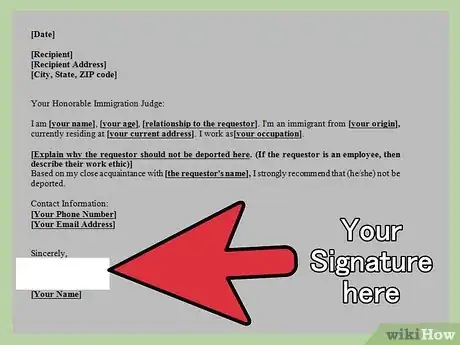This article was co-authored by Clinton M. Sandvick, JD, PhD. Clinton M. Sandvick worked as a civil litigator in California for over 7 years. He received his JD from the University of Wisconsin-Madison in 1998 and his PhD in American History from the University of Oregon in 2013.
wikiHow marks an article as reader-approved once it receives enough positive feedback. In this case, 85% of readers who voted found the article helpful, earning it our reader-approved status.
This article has been viewed 205,919 times.
If you know someone who is in deportation proceedings, then you may be asked to write a letter in support of that person. The letter is called a Letter in Support of Cancellation of Removal. You may be asked to explain how the deportation would affect the person’s spouse and family. You might write this letter in your professional capacity as a therapist or doctor, or simply as a friend. The best letters will be detailed and honest.
Steps
Preparing to Write the Letter
-
1Understand the need for the letter. Under federal law, non-citizens who commit certain crimes can be deported. However, some people may qualify to apply for pardons. The pardon is called a “Cancellation of Removal.”[1] These people can complete an application and give it to the judge in their removal proceedings.
- As part of the application, the non-citizen can submit letters from friends, families, and others. These letters can argue why the detained person should be allowed to stay in the country.
- Once a judge decides that a person qualifies for a pardon, then the judge must weigh the good things about the person against the bad things they have done. Ultimately, the judge must decide if the person “deserves” to stay in the country.[2] The purpose of the letter is to bolster the judge’s sense of the worth and value of the applicant.
-
2Understand what judges are looking for. The immigration judge will read the letter to get a better sense of the applicant as a person. Positive factors the judge will consider include:[3]
- family ties in the United States
- how hard the removal will be on the person’s family
- the applicant’s work record
- ties to business or property
- community service
- successful rehabilitation from drugs or other criminal behavior
- good character
Advertisement -
3Speak to the requestor. Before drafting the letter, you should try to understand why the requestor has asked you to write the letter. Does he or she want you to highlight specific incidents that illustrate good character? Is there something specific that the requestor wants you to write? You should try to understand why you were asked.
- Since the person requesting the letter could be in detention, communication could be difficult. If the person has a lawyer, you may want to speak to the lawyer. Although the lawyer cannot share confidential details about the case, you could use the lawyer as a go-between who can ask the requestor what the letter should be about.
-
4Give yourself time to write the letter. Ideally, you will have a couple of weeks. Unfortunately, you may be rushed to produce a letter within a day or two. No matter how much time you have, you should clear out a couple hours to sit down and outline what you want to say.
- Try to think of concrete examples to support any judgment you make. Even if you are talking about your feelings, you should be able to use specific examples to support your point.
- For example, suppose you want to explain why you would miss your daughter terribly if she is deported. You can support that statement by explaining how you grew closer by coming to the United States, since your daughter helped translate for you and helps you pay your bills. These details explain why you will miss her.
-
5Commit to being sincere. If you are writing a letter in support of a family member, then you should write from the heart.[4] If you are supporting an employee or a member of your organization (church, volunteer organization, etc.), then you should focus on being honest.
- Because sincerity is so important, you should not copy other people’s letters. Although you can look at sample letters to get a handle on formatting and length, you should always use your own words and ideas.
Writing the Letter
-
1Insert the date and a salutation. At the top of the letter, you should include the date. A couple lines down, include the salutation.[5] Since you are addressing a judge, your salutation should read, “Dear Immigration Judge” or “Your Honorable Immigration Judge.”[6]
- If you know the requestor in a professional capacity, then you should use letterhead.
-
2Include an introduction. Use the first paragraph to introduce yourself. State your name, age, relationship to the requestor, address, occupation and immigrant status.[7]
- Also state how long you have known the requestor.[8]
- If you are relative, you will state your relationship to the person detained: “I am Imelda Sanchez, the wife of Richard Sanchez. We have been married for six years and have known each other for nine years total. Richard is the father of my two children, Emily and Michael.”
- Alternately, if you are an employer, you would state that fact: “I am Bob Akin, the sole owner of Akin Carpentry, where I have supervised Simon Alfred for the past eighteen months.”
-
3Explain why the requestor should not be deported. In the second paragraph, you need to explain why you believe the person should not be removed from the country. Here is where you should refer to the reason why the requestor has asked you to write the letter. For example, if you are a family member, then you will want to describe the impact removal will have on your family. Describe in sufficient detail how the family relies on this person to pay bills and buy food. You should also describe the emotional ties the family shares with the detained person.[9]
- You could write, “My children and I rely on my husband every day. Without his job as a construction worker, we would not have enough money to pay the rent on our two bedroom apartment or to put much food on the table. Because of my disability, I have only been able to work part-time and therefore cannot support my two children on my own. Even more important is the love and support my husband provides our family.” Again, it is important to use your own words; explain your situation in sufficient detail.
- Alternately, you might have been asked to write a letter because you live in the country that the detainee would be deported back to. In your letter, you could explain the hardships that the person would face.[10] For example, the person may face religious persecution or extreme poverty.
-
4Describe work ethic, if relevant. If the requestor is an employee or volunteer, then you will want to include the requestor’s job title as well as their skills. Include information about the dates and location of employment and be detailed about why you find the requestor a good employee. Immigration judges are looking to see that those applying for Cancellation of Removal are hard-working and will be productive members of society should they stay.
- For example, you could write, “I have employed Mr. Alfred as a carpenter for the past eighteen months, beginning in March 2014 and ending when he was arrested by immigration officials. During that time, he never missed a day of work and even showed up when sick. He arrived on time and never left early, unlike my other employees.”
- You should also state your opinion of the requestor’s honesty and trustworthiness. Be specific.[11] For example, do not simply state, “I trust Mr. Alfred a lot.” That is too general—and unpersuasive. You will need details to show the reader why you believe the requestor has the character traits you say he does.
- Instead, you could write: “Within two months I felt comfortable leaving Mr. Alfred to supervise the other two workers on our team, whenever I had to go to the hardware store or to meet with a client. He supervised the other workers and made sure that they completed tasks on time. Within another four months, I trusted him to talk to clients directly. Just before his arrest, he was helping me collect payments from clients.”
-
5Conclude with a heartfelt recommendation. The letter should close with a strong recommendation that the requestor not be deported.[12] You can write, “Based on my close acquaintance with Ms. Amaya, I strongly recommend that she not be deported.”
-
6Add your contact information. In the final paragraph, include contact information so that the judge can reach you if necessary. Include your phone number and email address (if applicable) at the end of the letter. If your mailing address has not been included as part of the letterhead, then include the mailing address here as well. Also specify what times are best for reaching you.
- After adding the contact information, insert “Sincerely” and then space down a few lines and type your name.
-
7Sign the letter. Use blue or black ink. Because the requestor is in the middle of deportation proceedings, you should have the letter notarized.[13]
- Accordingly, you should wait to sign the letter until you appear before the notary public. Be sure to bring sufficient personal identification. A valid driver’s license or passport should be sufficient.
- To find a notary near you, use the locator from the American Society of Notaries. Notaries may also be found at most large banks or at courthouses.
References
- ↑ http://www.justice.gov/sites/default/files/eoir/legacy/2013/01/22/LPR%20Cancellation%20-%20English%20(5).pdf
- ↑ http://www.justice.gov/sites/default/files/eoir/legacy/2013/01/22/LPR%20Cancellation%20-%20English%20(5).pdf
- ↑ http://www.justice.gov/sites/default/files/eoir/legacy/2013/01/22/LPR%20Cancellation%20-%20English%20(5).pdf
- ↑ https://www.indeed.com/career-advice/career-development/supporting-letter
- ↑ http://www.goldengateimmigration.com/archives/797
- ↑ https://www.indeed.com/career-advice/career-development/supporting-letter
- ↑ https://www.indeed.com/career-advice/career-development/supporting-letter
- ↑ https://www.avvo.com/legal-guides/ugc/cancellation-of-removal---how-to-write-letters-of-support-for-cancellation-of-removal
- ↑ https://www.avvo.com/legal-guides/ugc/cancellation-of-removal---how-to-write-letters-of-support-for-cancellation-of-removal
- ↑ https://www.avvo.com/legal-guides/ugc/cancellation-of-removal---how-to-write-letters-of-support-for-cancellation-of-removal
- ↑ http://www.goldengateimmigration.com/archives/797
- ↑ http://www.goldengateimmigration.com/archives/797
- ↑ http://www.goldengateimmigration.com/archives/797
- ↑ https://www.avvo.com/legal-guides/ugc/cancellation-of-removal---how-to-write-letters-of-support-for-cancellation-of-removal
About This Article
If you need to write a letter requesting the non-deportation of someone, make sure to use an argument that a judge will respond to positively. For example, a judge may cancel a deportation because of the person’s familial ties in the United States, their work record, community service, or ties to a business property. As you write, be sincere and write from the heart explaining why the person shouldn’t be deported. When formatting your letter, use the first paragraph to introduce yourself and your relationship to the requestor, then use the body of the letter to explain your reasoning and recommend that they not be deported. Make sure to sign the letter and include your contact information so the judge can reach you directly. For more help from our legal co-author, including how to write your letter sincerely, read on.











































































